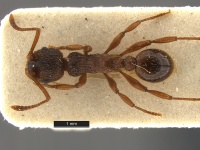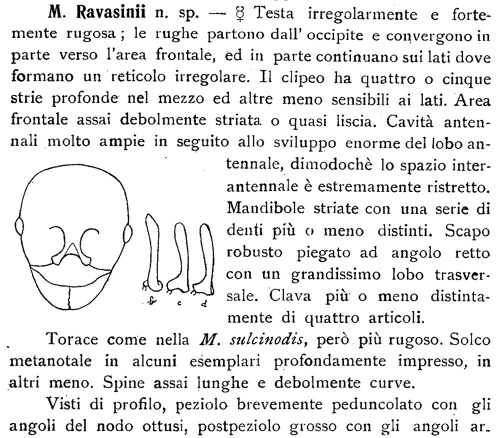Myrmica ravasinii
| Myrmica ravasinii | |
|---|---|

| |
| Scientific classification | |
| Kingdom: | Animalia |
| Phylum: | Arthropoda |
| Class: | Insecta |
| Order: | Hymenoptera |
| Family: | Formicidae |
| Subfamily: | Myrmicinae |
| Tribe: | Myrmicini |
| Genus: | Myrmica |
| Species: | M. ravasinii |
| Binomial name | |
| Myrmica ravasinii Finzi, 1923 | |
Myrmica ravasinii is generally a semi-xerophilous species, but is quite tolerant to various types of habitats although it avoids both more cool and wet beech forests, and more hot and dry archa (Juniper) forests. Nests are built in the soil, often under stones.
Identification
A member of the schencki group. It is one of the most peculiar Myrmica species found beyond the Himalaya, China and SE Asia areas. Its has the narrowest frons among all known Myrmica (mean FI 0.17) and an extraordinarily enlarged lobe on the scape bend that well distinguish it from any other known Myrmica worldwide. It also has a block-shaped petiole in profile with a short peduncle, long spines, big size and strong petiolar rugosity. Its males well differ from those of the other species of the schencki-group (except M. caucasicola) by the presence of long erect hairs on the scape, tibiae and tarsi. (Radchenko and Elmes 2010)
Keys including this Species
- Key to Myrmica of East Europe, West Siberia, northern Kazakhstan, Caucasus, Asia Minor, Turkmenistan and Iran
- Key to Myrmica of Romania
- Key to Myrmica of West Europe and North Africa
Distribution
Latitudinal Distribution Pattern
Latitudinal Range: 40.897222° to 40.606411°.
| North Temperate |
North Subtropical |
Tropical | South Subtropical |
South Temperate |
- Source: AntMaps
Distribution based on Regional Taxon Lists
Palaearctic Region: Albania (type locality), Armenia, Georgia, Greece, Russian Federation, Türkiye.
Distribution based on AntMaps
Distribution based on AntWeb specimens
Check data from AntWeb
Countries Occupied
| Number of countries occupied by this species based on AntWiki Regional Taxon Lists. In general, fewer countries occupied indicates a narrower range, while more countries indicates a more widespread species. |

|
Estimated Abundance
| Relative abundance based on number of AntMaps records per species (this species within the purple bar). Fewer records (to the left) indicates a less abundant/encountered species while more records (to the right) indicates more abundant/encountered species. |

|
Biology
Myrmica ravasinii is closely related to Myrmica pelops. The geographical range seems to be restricted to the Balkans and Asia Minor between 38. 42N and 20. 43 E. The main habitat is light forest, usually with Pinus, rarely dense pine forest. The elevation of the sites ranged from 800 to 1800 m, with the majority between 1200 and 1800 m. (Seifert 2003b)
Radchenko and Elmes (2010) - M. ravasinii is a semi-xerophilous species. The regions where it lives are very hot in summer therefore it is a mountain species usually living between 800 and 1800 m. Generally, it lives in fairly open forests (oak, fir, pine), where presumably it benefits from warmth in spring but shade in summer, though occasionally it has been found on mountains meadows. In very dry mountains it is often associated with the edges of small gullies where the sub-soil may be a little moist. Nests are built in the soil and in more shaded places it may live under stones. In southwest Turkey we found sexuals in nests in mid August, and Arakelyan (1989) found them in Armenia in a nest on 30th of August, so nuptial flights probably occur August-September.
Radchenko et al. (2016): Based on both our own, literature and collections’ data it could be argued that M. ravasinii is generally a semi-xerophilous species, but it seems to be quite tolerant to various types of habitats. Although the regions where it distributed are very hot in summer, it lives in mountains at altitudes between 800 and 2150 m a.s.l. where temperature is significantly lower than in plains. Here M. ravasinii inhabits predominantly various types of fairly open forests (oak, pine, hornbeam, abies), but avoids both more cool and wet beech forests, and more hot and dry archa (Juniper) forests. In drier woods it is often associated with the edges of small gullies where the sub-soil may be a little moist. At the same time, it was also found on subalpine meadows. Nests are built in the soil, often under stones. In southwest Turkey sexuals were found in nests on 18ht and 20th of August, but to the north, in Armenia, they were found on 30th of August (Arakelyan 1989, Seifert 2003, Radchenko et al. 2006, Radchenko & Elmes 2010, Elmes, personal communication 2015, Radchenko, unpublished data).
Castes
Workers, queens and males are described.
Nomenclature
The following information is derived from Barry Bolton's Online Catalogue of the Ants of the World.
- ravasinii. Myrmica ravasinii Finzi, 1923: 2, fig. (w.) ALBANIA. Arakelian, 1989: 734 (q.m.). See also: Finzi, 1926: 112; Seifert, 2003b: 150; Radchenko, Elmes & Alicata, 2006: 519; Radchenko & Elmes, 2010: 223.
Unless otherwise noted the text for the remainder of this section is reported from the publication that includes the original description.
Description
Type Material
Radchenko, Elmes and Alicata (2006) - 3 workers, syntypes “Albania, Tomor, 1600 m, 1922” (ZMMU, MIZ, Institute of Zoology of the Ukranian National Academy of Sciences); non-type material: about one hundred workers, more than 20 males and queens from Georgia, Armenia and Turkey (ZMMU, Institute of Zoology of the Ukranian National Academy of Sciences, Graham W. Elmes).
Etymology
Radchenko and Elmes (2010) - named for Prof. Carlo Ravasini (1874-1959) of Trieste, a doctor (urologist) and amateur coleopterologist who made the 1923 Ravasini-Lona expedition to Albania; they made their ant collection available to Finzi.
References
- Arakelian, G. R. 1989. Previously unknown sexual individuals of the ant Myrmica ravasinii Finzi (Hymenoptera, Formicidae) from Armenia. Biol. Zh. Arm. 42: 733-736. (page 734, queen, male described)
- Radchenko, A.G. & Elmes, G.W. & Alicata, A. 2006. Taxonomic revision of the schencki-group of the ant genus Myrmica from the Palaearctic region. Annales Zoologici (Warszawa) 56: 499-538.
- Radchenko, A.G. & Elmes, G.W. 2010. Myrmica ants of the Old World. Fauna Mundi 3: 1-789.
- Finzi, B. 1923. Risultati scientifici della spedizione Ravasini-Lona in Albania. III. Formiche. Estratto dal Bollettino della Societa Entomologica Italiana 55:1-4. (page 2, fig. worker described)
- Borowiec, L. 2014. Catalogue of ants of Europe, the Mediterranean Basin and adjacent regions (Hymenoptera: Formicidae). Genus (Wroclaw) 25(1-2): 1-340.
- Czekes, Z., Radchenko, A.G., Csosz, S., sz-Len, A.S., Tausan, I., Benedek, K., Mark, B. 2012. The ant genus Myrmica Latreille, 1804 (Hymenoptera: Formicidae) in Romania: distribution of species and key for their identification. Entomologica Romanica 17: 29-50.
- Finzi, B. 1926. Le forme europee del genere Myrmica Latr. Primo contributo. Boll. Soc. Adriat. Sci. Nat. Trieste 29: 71-119 PDF (page 112, see also)
- Kiran, K., Karaman, C. 2020. Additions to the ant fauna of Turkey (Hymenoptera, Formicidae). Zoosystema 42(18), 285-329 (doi:10.5252/zoosystema2020v42a18).
- Radchenko, A., Yusupov, Z., Komarov, Y. 2016. New data on the distribution and ecology of Myrmica ravasinii Finzi, 1923 (Hymenoptera, Formicidae). Asian Myrmecology 8, 1–7 (doi:10.20362/am.008011).
- Seifert, B. 2003b. The Palaearctic members of the Myrmica schencki group with description of a new species (Hymenoptera: Formicidae). Beitr. Entomol. 53: 141-159 PDF
References based on Global Ant Biodiversity Informatics
- Andoni V. 1977. Kontribut mbi Himenopteret e familjes Formicidae te vendit tone. Buletini I Shkencave te Natyres 31(2): 93-101.
- Borowiec L. 2014. Catalogue of ants of Europe, the Mediterranean Basin and adjacent regions (Hymenoptera: Formicidae). Genus (Wroclaw) 25(1-2): 1-340.
- Borowiec L., and S. Salata. 2012. Ants of Greece - Checklist, comments and new faunistic data (Hymenoptera: Formicidae). Genus 23(4): 461-563.
- Czekes Z., Radchenko, A. G., Csősz, S. Szász-Len, A., Tăuşan, I., Benedek, K., and Markó, B. 2013. The genus Myrmica Latreille, 1804 (Hymenoptera: Formicidae) in Romania: distribution of species and key for their identification. Entomologica Romanica 17: 29-50.
- Dubovikoff D. A., and Z. M. Yusupov. 2018. Family Formicidae - Ants. In Belokobylskij S. A. and A. S. Lelej: Annotated catalogue of the Hymenoptera of Russia. Proceedingss of the Zoological Institute of the Russian Academy of Sciences 6: 197-210.
- Finzi B. 1926. Le forme europee del genere Myrmica Latr. Primo contributo. Bollettino della Società Adriatica di Scienze Naturali in Trieste. 29: 71-119.
- Finzi, B. "Risultati scientifici della spedizione Ravasini-Lona in Albania. III. Formiche." Bollettino della Società Entomologica Italiana 55 (1923): 1-4.
- Gratiashvili N., Barjadze S. 2008. Checklist of the ants (Formicidae Latreille, 1809) of Georgia. Proceedings of the Institute of Zoology (Tbilisi) 23: 130-146.
- Karaman C., K. Kiran, and V. Aksoy. 2014. New records of the genus Strumigenys Smith, 1860 (Hymenoptera, Formicidae) from Black Sea region of Turkey. Trakya University Journal of Natural Sciences, 15(2): 59-63.
- Kiran K., and C. Karaman. 2012. First annotated checklist of the ant fauna of Turkey (Hymenoptera: Formicidae). Zootaxa 3548: 1-38.
- Petrov I. Z., and C. A. Collingwood. 1992. Survey of the myrmecofauna (Formicidae, Hymenoptera) of Yugoslavia. Archives of Biological Sciences (Belgrade) 44: 79-91.
- Radchenko A. G., and G. W. Elmes. 2010. Myrmica ants (Hymenoptera: Formicidae) of the Old World. Fauna Mundi 3. Warsaw: Natura Optima Dux Foundation, 790 pp.
- Radchenko A., Z. Yusupov, and Y. Komarov. 2016. New data on the distribution and ecology of Myrmica ravasinii Finzi, 1923 (Hymenoptera, Formicidae). Asian Myrmecology 8: 1-7. DOI: 10.20362/am.008011
- Radchenko A.G., G. W. Elmes, and A. Alicata. 2006. Taxonomic revision of the schencki-group of the ant genus Myrmica from the Palaearctic region. Annales Zoologici (Warszawa) 56: 499-538.
- Seifert B. 1988. A taxonomic revision of the Myrmica species of Europe, Asia Minor, and Caucasia (Hymenoptera, Formicidae). Abhandlungen und Berichte des Naturkundemuseums Görlitz 62(3): 1-75.
- Seifert B. 2003. The Palaearctic members of the Myrmica schencki group with description of a new species (Hymenoptera: Formicidae). Beiträge zur Entomologie 53: 141-159.
- Seifert, B. "The Paleartic members of the Myrmica schenki group with description of a new species." Beitr. Entomol. 53 (1) (2003): 141-159.



